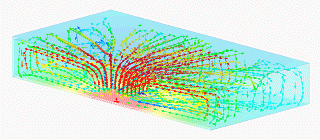craig588 posted:That's just a heat pipe without the capillary material so it'll only work in one orientation. Mmm I don't know what you mean in relation to that drawing (although I'm not saying you're wrong). The concept is the water boils at 30*C then returns to water form once it drops back below 30 degrees, which would be primarily in the radiator. The heat removed is from the phase change around the heatsink. However, not only do I not have any sort of thermodynamics knowledge to know if this is actually better or worse than traditional methods, it would likely have to be larger (just guessing), practically speaking keeping it under that sort of vacuum would require some pretty robust construction (although the vacuum itself is attainable cheap enough at that level) and might have to be maintained every once in a while by a vacuum pump. But the most glaring flaw, if everything else actually worked, is that changing from liquid to gas would actually raise the pressure which would change the dynamics of the whole system. If it were possible at all it would be a clever balancing act that I am not capable of figuring out. Well, not equipped to anyway Edit: Or would the fact that the pressure rises actually helps the water vapor return to water form faster thus increasing the vacuum back to its original state over and over Ignoarints fucked around with this message at 17:20 on Apr 15, 2014 |
|
|
|
|

|
| # ? Apr 18, 2024 20:20 |
|
Heat pipes work by boiling a fluid, the fluid evenly covers the interior surface of the heat pipe through capillary action. When a portion of the fluid is boiled off the other still liquid parts automatically move to take its place because that's what capillary forces do. The hot gas is moved away from the heat source to take the place of the moved liquid where it then condenses and returns to a liquid and the cycle repeats forever. Better heat pipes have their interior surface covered in sintered copper which looks like this, cheaper ones will use a braided wick or even cheaper ones will just have groves formed into them. As far as I can see you're literally describing a less effective heat pipe, using water instead of an engineered fluid and no capillary material.
|
|
|
craig588 posted:Heat pipes work by boiling a fluid, the fluid evenly covers the interior surface of the heat pipe through capillary action. When a portion of the fluid is boiled off the other still liquid parts automatically move to take its place because that's what capillary forces do. The hot gas is moved away from the heat source to take the place of the moved liquid where it then condenses and returns to a liquid and the cycle repeats forever. Better heat pipes have their interior surface covered in sintered copper which looks like this, cheaper ones will use a braided wick or even cheaper ones will just have groves formed into them. Nice, I didn't know heat pipes worked that way. I thought at best they were just full of a liquid. Wow this is literally what was going through my head in a much larger and far cruder way.  So efb with every air cooler with heat pipes on the market 
|
|
|
|
|
CapTherm beat you to it with a working design with their MP1120 (assuming it ever actually comes out)
|
|
|
atomicthumbs posted:CapTherm beat you to it with a working design with their MP1120 (assuming it ever actually comes out) Literally exactly it, except with some sort of fluid that boils at room temperature instead of forcing a vacuum to lower boiling point edit: https://www.youtube.com/watch?v=CIbnl3Pj15w dammit 3m already did it too Ignoarints fucked around with this message at 22:20 on Apr 15, 2014 |
|
|
|
|
The first review of the Noctua NH-D15 is in, which is Noctua's response to the reigning TC14PE. The D15 performs very well, and is equal to .5 degrees cooler than the TC14PE. They recorded the noise profiles as "very identical" in their words. The main downsize of the D15 is that it is HUGE. Like, seriously massive. It blocks the first slot of a motherboard, which is not a problem with fullsize ATX boards that aren't aimed towards Quad Sli (and hence only a PCI-E 1x connector is lost), but on mATX or ITX it renders the top 16x slot unusable, which is likely a deal breaker for many. The big upside to the Noctua is easy of installation, which is a Noctua hallmark. I'd still lean towards the TC14PE personally, as the only fiddly part of the install is the fan clips really (I installed one for a mate). The review also really highlights that there is no reason to buy a D14 and there hasn't been for a while, it gets soundly beaten by everything there including the significantly smaller single fan U14S. EDIT: Forgot to mention, the D15 also a longer warranty at 6 years, and supports taller ram modules in single fan mode compared to the other heatsinks due to a cutout. BurritoJustice fucked around with this message at 10:58 on Apr 16, 2014 |
|
|
BurritoJustice posted:The first review of the Noctua NH-D15 is in, which is Noctua's response to the reigning TC14PE. The D15 performs very well, and is equal to .5 degrees cooler than the TC14PE. They recorded the noise profiles as "very identical" in their words. The main downsize of the D15 is that it is HUGE. Like, seriously massive. It blocks the first slot of a motherboard, which is not a problem with fullsize ATX boards that aren't aimed towards Quad Sli (and hence only a PCI-E 1x connector is lost), but on mATX or ITX it renders the top 16x slot unusable, which is likely a deal breaker for many. The big upside to the Noctua is easy of installation, which is a Noctua hallmark. I'd still lean towards the TC14PE personally, as the only fiddly part of the install is the fan clips really (I installed one for a mate). I'd just... man just watercool for the sake of not having that on your motherboard lol.
|
|
|
|
|
Ignoarints posted:
Rather have an NH-D15. Dunno, too much to go wrong in a watercooler, and Noctua stuff is just sexy.
|
|
|
HalloKitty posted:Rather have an NH-D15. Dunno, too much to go wrong in a watercooler, and Noctua stuff is just sexy. I definitely prefer AIO even compared to even moderately sized air coolers. But its now just a matter of personal preference it seems. Watercoolers do have higher potential for gently caress ups technically, but as far as I know they don't leak anymore or anything. Sealing a hose isn't particularly hard nor is a pump a complex machine but that is two more things than an air cooler has.
|
|
|
|
|
AIO are nice cause i can do things like, unplug 8 pin psu cables without having to remove a giant loving heatsink.
|
|
|
|
I adore my cheap as hell H60 on my de-lidded i5. Giant air cooling is interesting academically but honestly I don't get obsessions with, say, sub-5 degrees C differences. At voltages that won't hose your CPU in under a year you aren't going to be thermally limited while running any good cooler, air or closed-loop.
|
|
|
ShaneB posted:I adore my cheap as hell H60 on my de-lidded i5. Giant air cooling is interesting academically but honestly I don't get obsessions with, say, sub-5 degrees C differences. At voltages that won't hose your CPU in under a year you aren't going to be thermally limited while running any good cooler, air or closed-loop. Yeah and if you're willing to go $100 for an air cooler, $100 AIO works better anyways. I sort of wanted a dual radiator but after I while I just figured whats the point. I *might* get another 100 mhz out of it but I'm already pushing vcore limits and I can't even break 80C now.
|
|
|
|
|
ShaneB posted:I adore my cheap as hell H60 on my de-lidded i5. Giant air cooling is interesting academically but honestly I don't get obsessions with, say, sub-5 degrees C differences. At voltages that won't hose your CPU in under a year you aren't going to be thermally limited while running any good cooler, air or closed-loop.
|
|
|
|
Alereon posted:I disagree, the performance gulf between AIO water and air cooling is very significant. You can achieve comparable absolute temperatures to air cooling, but the noise level with liquid cooling is much higher, so really if you don't need that much more performance it would seem to make the most sense to get a less expensive single-fan air cooler. Similarly, if you don't care about noise as much, just get that less expensive air cooler and turn the fan speed up. What less-expensive single fan air cooler do you suggest? The performance gap between a 212 and an H60 is huge, as is the noise at high temperatures as the fan spins up on the 212. I haven't used any of the other options, however.
|
|
|
|
As far as I know it's difficult to find a $60-$70 AIO that is as quiet as similarly priced noctua air cooler. It kind of goes the other way once you go $85+, barely. A U14S at 100% and pwm is amazingly quiet, where an h80i is technically less noisy in quiet mode but definitely noisier at 100%, but it does do better. If you go up to h100 style stuff its just as good in silent mode as 100% for a U14S, with more on the table if you do push the fans but that's entering a different price bracket. Even though we're talking $20-$30 between all these things. As far as noisy ones go I have a pretty noisy one (performer 2.0) but my video cards completely overwhelm it. It is a non issue for me. I'd rather not have big air ever again honestly just for convenience. Once you get up into the $60+ range as long as you choose the better AIO or air of the bunch the real differences are so mild to me that personal preference takes over. For me it came down to having issues fitting "normal" large air coolers with my motherboard heatsinks that I just decided whatever, I'll just get a cheap AIO. Worked great. Ignoarints fucked around with this message at 19:35 on Apr 16, 2014 |
|
|
|
|
I have a D14 on my CPU and a H100 on my videocard and the H100 pump is by far the loudest thing in my computer. The included H100 fans were also incredibly loud, but I was able to run the H100 passively just through the positive pressure from my case fans.
|
|
|
|
Sorry I meant h100i.
|
|
|
|
|
I thought about going with a CLC when I rebuilt my desktop, but with aftermarket videocard cooling and a Thermalright heatsink I ended up deciding that the pump noise wasn't worth it. Glad I skipped out, at least going by the last couple pages of comments. Also I think it's a little hilarious that that review posted promotes buying an aircooler that, in 2014, is so large as to block PCI-E ports for a marginal increase in cooling performance. If they're going to make something that large they hopefully made it possible to just run it semi-passively.
|
|
|
cisco privilege posted:I thought about going with a CLC when I rebuilt my desktop, but with aftermarket videocard cooling and a Thermalright heatsink I ended up deciding that the pump noise wasn't worth it. Glad I skipped out, at least going by the last couple pages of comments. What kind of video card cooler do you have? I'm starting to wonder if I can get something out of that
|
|
|
|
|
I have a Havik dual 140mm heatsink, but the included fans are the loudest thing in my system (I went and stopped each fan with my finger to confirm). The thing is, I'm not currently overclocked and according to reviews and benchmarks these are supposed to be whisper quiet when the CPU is idle. I'm turning down the RPM settings as far as I can in the BIOS but it is still pretty loud and they are spinning pretty drat fast. It there maybe some kind of resistor or something that can throttle these further? Here's the item in question: http://www.amazon.com/NZXT-HAVIK-Cooler-Dual-140MM/dp/B005869XYK This is on an Asus Z87-A
|
|
|
|
ShaneB posted:What less-expensive single fan air cooler do you suggest? The performance gap between a 212 and an H60 is huge, as is the noise at high temperatures as the fan spins up on the 212. I haven't used any of the other options, however. Zero VGS posted:I have a Havik dual 140mm heatsink, but the included fans are the loudest thing in my system (I went and stopped each fan with my finger to confirm). The thing is, I'm not currently overclocked and according to reviews and benchmarks these are supposed to be whisper quiet when the CPU is idle. I'm turning down the RPM settings as far as I can in the BIOS but it is still pretty loud and they are spinning pretty drat fast. It there maybe some kind of resistor or something that can throttle these further? Here's the item in question:
|
|
|
|
Ignoarints posted:What kind of video card cooler do you have? I'm starting to wonder if I can get something out of that 
|
|
|
|
I'm starting to get a weird issue where my computer will shut down the moment the windows splash screen pops up. It only happens every once in a while, but when it does I cannot boot until I load defaults in my bios, boot, then reboot and reload the overclocking profile. Then it works fine. Kind of annoying though. Could this indicate a major problem? There have been no changes other than actually dropping to 1 video card for the time being. I believe it was happening a little before that though anyway
|
|
|
|
|
Unstable overclock or power supply issue most-likely. I'd look at the overclock first - it may pass POST and work most of the time, but if there's instability it can cause problems with booting and/or coming out of sleep mode. You've either got the chip pushed too far or it doesn't have enough voltage, although you're probably at your vcore limit already going by your other posts in the thread. Try backing the CPU down 100mhz or so and see if it stops causing issues - then you'll know if that's the cause.
|
|
|
|
It's already been backed down to 4.5 for a while, and I was running quite a bit more vcore before but perhaps it is still too low for 4.5 or I have damaged it. It seems, so far, to only happen when I try to turn it on it when its been off for a while (as in like a day) but I can't be sure about that yet. Edit: And it hasnt done it again yet. I dont want to touch anything at all until I can get it repeatable.. Ignoarints fucked around with this message at 16:05 on Apr 24, 2014 |
|
|
|
|
Just curious - I'm looking at getting an i5-based build and thought about doing the heat spreader removal, since a lot of people mentioned the thermal paste Intel used between the die and heat spreader wasn't that great. Would I need to do anything special to make sure that the CPU cooler makes contact with the die after the spreader is off? I didn't know if any modifications would need to be made, since removing the heat spreader would potentially leave a couple millimeter gap where the cooler would usually contact the spreader.
|
|
|
|
I believe there is a plate on an upcoming motherboard but... you can just put it back on. You drop 15+ degrees by removing the old glue/tim and using new
|
|
|
|
|
Ozz81 posted:Just curious - I'm looking at getting an i5-based build and thought about doing the heat spreader removal, since a lot of people mentioned the thermal paste Intel used between the die and heat spreader wasn't that great. Would I need to do anything special to make sure that the CPU cooler makes contact with the die after the spreader is off? I didn't know if any modifications would need to be made, since removing the heat spreader would potentially leave a couple millimeter gap where the cooler would usually contact the spreader. This is all rong. The problem with IB/HW chips is the glue they use to attach the heat spreader to the package, the TIM Intel uses is above average. I just de-lidded mine using the razor method (because the hammer method failed me) and you can really tell how loving inconsistent the glue deposition is, 3 of my corners were really thick with the stuff and the fourth corner was extremely thin, that last corner was extremely hard to slice. Afterwards I lapped the top of the spreader (because the hammer method deformed the edges slightly) using my many times many whetstones (16000 grit ceramic whetstone ahoooyyy). I replaced the TIM with Ceramique. Load temps are now 35°C lower load, total delta between idle and load is now 15°C, viva NH-D14. deimos fucked around with this message at 15:37 on Apr 28, 2014 |
|
|
deimos posted:This is all rong. The problem with IB/HW chips is the glue they use to attach the heat spreader to the package, the TIM Intel uses is above average. The same thing happened to me with the hammer. I even had a better-than-typical vice with smooth and precise edges and I was demolishing wood on the cpu. I even tried using my knife wood block which is super hard and made cpu shaped indentations in it. I rolled the edges on the IHS but I didn't lap, although I plan to. Even so I got 15-18 degree drop depending on core. Since the flatness is important I would actually expect further drop by lapping however even a few degrees won't matter in my case since I'm at uncomfortably high vcore for the next step up. But yeah that glue was a mess. I can just see some dude leaning back in a dimly lit room and half assingly squirting glue on PCBs as they roll by on a conveyor belt
|
|
|
|
|
I have a 2500k with an ASUS P8P67 motherboard that I'm trying to overclock. The problem is that I'm missing some settings with Turbo Ratio being the most important one. I did some research through Google and it seems to be a common problem. It appears the solution, found here that works the best is flashing the BIOS and the ME region specifically. When I went to download the FTK program to try it Chrome starting going nuts with malware warnings which stopped me. Is there a better way? Has people here used this method and had no problems with the download? Should I just buy a new BIOS chip and be done with it? Thanks for reading!
|
|
|
|
What revision is the board? Have you tried just updating the BIOS normally before attempting weird BIOS modding? Try doing that, reset the BIOS settings to default, and see if the options are available.
|
|
|
|
cisco privilege posted:What revision is the board? Have you tried just updating the BIOS normally before attempting weird BIOS modding? It is Rev. 3.1. The BIOS was already the latest version but I did reinstall it plus reset the CMOS.
|
|
|
|
This is a pretty old guide but it's tailored to your board: http://www.overclockers.com/forums/showthread.php?t=675134 See if anything in there helps. It's probably not ideal but it should help you get started. 42 is an easy multiplier to hit straight-out but it can probably go higher.
|
|
|
|
How hard is the ceiling is that 1.38 for voltage? Does it just affect longevity of the CPU and board? I had a pretty stable run last night at 4.8 with 1.415 using the settings from an ASUS thread. When I dropped the voltage down to 1.35 and 1.38 I had a BSOD and a lockup. I see that some people have been good for a couple years at that voltage and since I plan on upgrading my CPU and board within the year, so if longevity is the factor for going above 1.38 I'll try the 1.415 for awhile.
jabro fucked around with this message at 20:44 on May 5, 2014 |
|
|
jabro posted:How hard is the ceiling is that 1.38 for voltage? Does it just affect longevity of the CPU and board? I had a pretty stable run last night at 4.8 with 1.415 using the settings from an ASUS thread. When I dropped the voltage down to 1.35 and 1.38 I had a BSOD and a lockup. I see that some people have been good for a couple years at that voltage and since I plan on upgrading my CPU and board within a couple of years if longevity is the factor for going above 1.38 I'll try the 1.415 for awhile. The only actual hard limit is 1.52 volts, but the generally accepted "limit" is 1.38 for those based on Intel info and data from others (supposedly, I only looked deep into Haswell). If you're thinking in years you really don't want to go above 1.38. All voltages in these ranges will reduce lifespan, but all chips have a lifespan at any voltage. It isn't linear, imagine it as a curve, but every chip will be a little different (some a lot). Just see how fast you can get with 1.38. You might have to bump it down to 4.7, you won't be able to tell the difference. I have mine a Haswell at 1.38 or so as well, but I'm not even expecting it to last a few years honestly. It could, but I'm not expecting it to. I'd run in the low 1.4's if it made any difference for me but it really doesn't in my case - but again I'm not expecting it to last for years.
|
|
|
|
|
Ignoarints posted:The only actual hard limit is 1.52 volts, but the generally accepted "limit" is 1.38 for those based on Intel info and data from others (supposedly, I only looked deep into Haswell). If you're thinking in years you really don't want to go above 1.38. All voltages in these ranges will reduce lifespan, but all chips have a lifespan at any voltage. It isn't linear, imagine it as a curve, but every chip will be a little different (some a lot). I'm sorry, I edited my post right now. I meant to say that I plan on grading my CPU and motherboard within the year, not years. I apologize for that. Need to proofread.
|
|
|
jabro posted:I'm sorry, I edited my post right now. I meant to say that I plan on grading my CPU and motherboard within the year, not years. I apologize for that. Need to proofread. If you can do 4.7 stable at 1.38 (or less) I would still pick that over 1.4x. The higher you go the further up the "curve" you're going, if you get what I mean. 1.38 is still quite high when you consider what stock is. But as far as literally will it just explode at 1.415 then no it most likely will not. Just make sure power saving features that apply to voltage are on and chances are greater than not that it will last a year. I'm assuming you aren't doing calculations 24/7 or rendering for 12 hours a day too, this is just normal usage stuff. edit: Use HW monitor or Aida 64 or something to view your actual vcore. This can be different than VID (what you set). It usually doesn't matter but since you're in the 1.4's I'd recommend knowing if it is actually isn't 1.415 Ignoarints fucked around with this message at 20:52 on May 5, 2014 |
|
|
|
|
Ignoarints posted:If you can do 4.7 stable at 1.38 (or less) I would still pick that over 1.4x. The higher you go the further up the "curve" you're going, if you get what I mean. 1.38 is still quite high when you consider what stock is. I'm using HW Monitor to view the actual voltage and temps. I'll drop it to 4.7 and 1.38 to see how it goes. Doesn't sound as cool as 4.8 though.  Thanks everyone for answering my questions.
|
|
|
jabro posted:I'm using HW Monitor to view the actual voltage and temps. I'll drop it to 4.7 and 1.38 to see how it goes. Doesn't sound as cool as 4.8 though. I know how it goes. I wanted to be at 4.6 (haswell isnt as high) for a long time, and I could at 1.4x but I just dropped to 4.5 and there was no real difference. The real difference was being over 1 ghz over stock, not that extra 100mhz
|
|
|
|
|

|
| # ? Apr 18, 2024 20:20 |
|
Alright, so I've got my computer built and everything is stable pre-overclock according to MemTest86+ and several Prime95 runs. Once I have all my files transferred over and a system backup made, I'll begin OC testing. The OC-important parts of the build in question are: quote:Motherboard: ASRock Z87 Extreme4 (BIOS/UEFI is latest version) SO. What exactly would the overclock process be for me, given the build? What settings do I ramp up, how much do I ramp them up by, where should I stop, what is too hot, etc. This is the first time I've dabbled with this, so I want to make sure I've got everything as clear as possible before I start doing horrible things to my system.
|
|
|


















